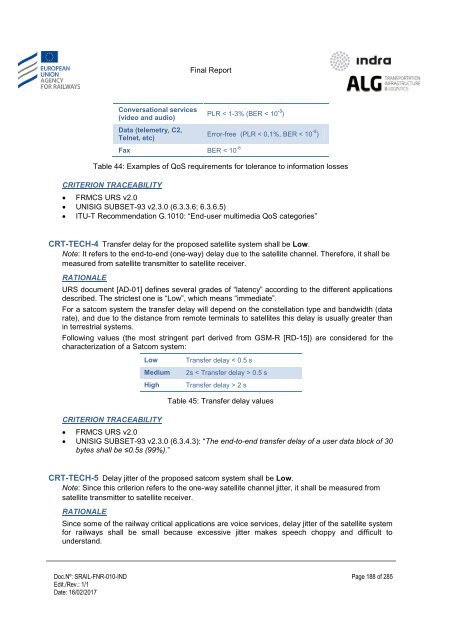Study on feasibility of SATCOM for railway communication
SRAIL-FNR-010-IND%20-%20FinalReport_v1.1_20170216
SRAIL-FNR-010-IND%20-%20FinalReport_v1.1_20170216
You also want an ePaper? Increase the reach of your titles
YUMPU automatically turns print PDFs into web optimized ePapers that Google loves.
Final Report<br />
C<strong>on</strong>versati<strong>on</strong>al services<br />
(video and audio)<br />
Data (telemetry, C2,<br />
Telnet, etc)<br />
Fax BER < 10 -6<br />
PLR < 1-3% (BER < 10 -3 )<br />
Error-free (PLR < 0,1%, BER < 10 -8 )<br />
Table 44: Examples <strong>of</strong> QoS requirements <strong>for</strong> tolerance to in<strong>for</strong>mati<strong>on</strong> losses<br />
CRITERION TRACEABILITY<br />
FRMCS URS v2.0<br />
UNISIG SUBSET-93 v2.3.0 (6.3.3.6; 6.3.6.5)<br />
ITU-T Recommendati<strong>on</strong> G.1010: ―End-user multimedia QoS categories‖<br />
CRT-TECH-4 Transfer delay <strong>for</strong> the proposed satellite system shall be Low.<br />
Note: It refers to the end-to-end (<strong>on</strong>e-way) delay due to the satellite channel. There<strong>for</strong>e, it shall be<br />
measured from satellite transmitter to satellite receiver.<br />
RATIONALE<br />
URS document [AD-01] defines several grades <strong>of</strong> ―latency‖ according to the different applicati<strong>on</strong>s<br />
described. The strictest <strong>on</strong>e is ―Low‖, which means ―immediate‖.<br />
For a satcom system the transfer delay will depend <strong>on</strong> the c<strong>on</strong>stellati<strong>on</strong> type and bandwidth (data<br />
rate), and due to the distance from remote terminals to satellites this delay is usually greater than<br />
in terrestrial systems.<br />
Following values (the most stringent part derived from GSM-R [RD-15]) are c<strong>on</strong>sidered <strong>for</strong> the<br />
characterizati<strong>on</strong> <strong>of</strong> a Satcom system:<br />
Low<br />
Medium<br />
High<br />
CRITERION TRACEABILITY<br />
Transfer delay < 0.5 s<br />
2s < Transfer delay > 0.5 s<br />
Transfer delay > 2 s<br />
Table 45: Transfer delay values<br />
FRMCS URS v2.0<br />
UNISIG SUBSET-93 v2.3.0 (6.3.4.3): ―The end-to-end transfer delay <strong>of</strong> a user data block <strong>of</strong> 30<br />
bytes shall be ≤0.5s (99%).‖<br />
CRT-TECH-5 Delay jitter <strong>of</strong> the proposed satcom system shall be Low.<br />
Note: Since this criteri<strong>on</strong> refers to the <strong>on</strong>e-way satellite channel jitter, it shall be measured from<br />
satellite transmitter to satellite receiver.<br />
RATIONALE<br />
Since some <strong>of</strong> the <strong>railway</strong> critical applicati<strong>on</strong>s are voice services, delay jitter <strong>of</strong> the satellite system<br />
<strong>for</strong> <strong>railway</strong>s shall be small because excessive jitter makes speech choppy and difficult to<br />
understand.<br />
Doc.Nº: SRAIL-FNR-010-IND<br />
Edit./Rev.: 1/1<br />
Date: 16/02/2017<br />
Page 188 <strong>of</strong> 285


